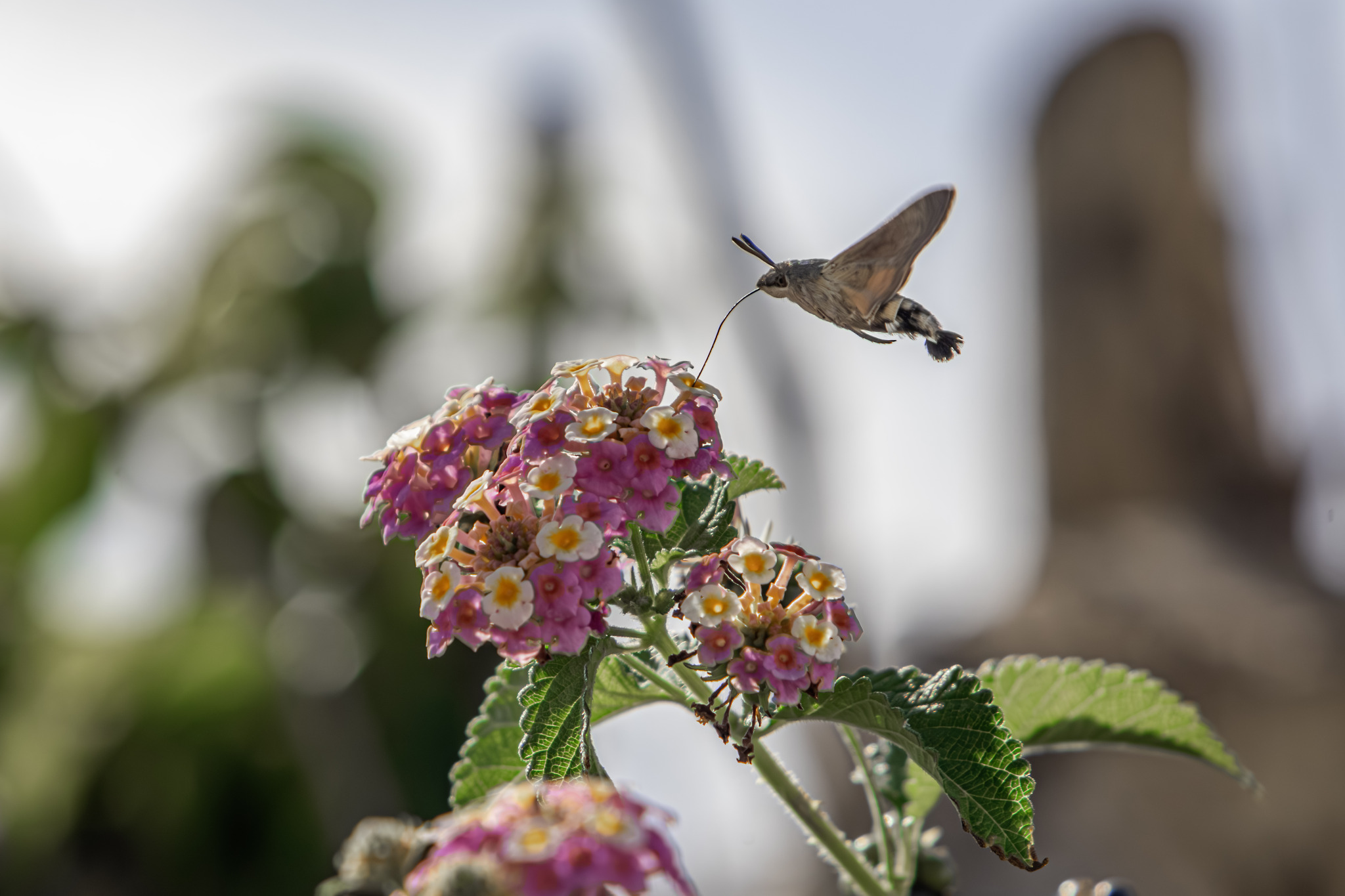The Hummingbird Hawk-Moth (Macroglossum stellatarum) is a fascinating day-flying moth known for its remarkable resemblance to hummingbirds in both appearance and behavior. It hovers in front of flowers to feed, rapidly flapping its wings and darting from bloom to bloom, mimicking the actions of a hummingbird. This unique moth is found across Europe, North Africa, and parts of Asia, and is a frequent visitor to gardens during the warmer months.
Physical Description:
- Size: The wingspan of the Hummingbird Hawk-Moth ranges from 40 to 45 mm. Its body is relatively plump and streamlined, contributing to its bird-like appearance when in flight.
- Coloration: The forewings are brownish-grey with darker, wavy lines, giving the moth excellent camouflage against tree bark and rocks. The hindwings are bright orange, creating a striking contrast when the moth is flying. The body is also covered in soft, brownish-grey hairs.
- Wings: Its wings are long and narrow, enabling it to hover and maneuver like a hummingbird. The wings move at high speeds, creating a humming sound similar to that of hummingbirds, which further adds to the illusion.
- Antennae: The moth has short, clubbed antennae, which are characteristic of the hawk-moth family.
Behavior:
- Flight and Feeding: The most distinctive behavior of the Hummingbird Hawk-Moth is its ability to hover in front of flowers while feeding. It uses its long proboscis (up to 2.5 cm) to sip nectar from deep, tubular flowers. Unlike many moths, this species is diurnal, meaning it is active during the day, especially in bright sunlight.
- Mimicry: Its flight pattern, rapid wing beats, and ability to hover while feeding closely mimic the behavior of hummingbirds. It moves swiftly between flowers, and its wing movements produce a faint humming sound, which enhances the illusion.
- Migration: The Hummingbird Hawk-Moth is a migratory species, often moving northward in the summer months from southern Europe and North Africa. In mild winters, some populations may overwinter as adults, but in colder regions, they die off after laying eggs.
Habitat:
The Hummingbird Hawk-Moth thrives in a variety of habitats, including:
- Gardens and parks: It is frequently seen in gardens with abundant nectar sources, making it a favorite among gardeners and butterfly enthusiasts.
- Meadows and grasslands: Wildflowers in open, sunny meadows provide excellent foraging opportunities.
- Woodland edges and scrubland: These areas provide shelter and a variety of flowering plants for feeding.
- Urban areas: The moth is often seen in cities and towns, attracted to gardens with flowers such as buddleia, petunias, and honeysuckle.
Life Cycle:
- Eggs: Females lay small, pale green eggs on the leaves of host plants, primarily species in the bedstraw family (Galium), such as cleavers or hedge bedstraw. The eggs are laid singly on the underside of leaves.
- Caterpillars: The caterpillars are green with white stripes running along their sides and are sometimes marked with small spots. They have a characteristic curved horn on the rear, like other hawk-moth caterpillars. The larvae feed on the leaves of the host plants.
- Pupation: The caterpillars eventually pupate in loose cocoons on the ground, often among leaf litter or in cracks in the soil. The pupal stage typically lasts a few weeks before the adult moth emerges.
- Generations: Depending on the climate, the Hummingbird Hawk-Moth can produce one or two generations per year, with adults emerging in spring and summer.
Distribution:
The Hummingbird Hawk-Moth has a wide range across Europe, North Africa, and parts of Asia. It is commonly found from the Mediterranean region up to northern Europe, including the UK, and extends as far east as Japan. The moth is migratory and can travel long distances, so it is often spotted in regions where it does not breed, particularly during the warmer months.
Conservation Status:
The Hummingbird Hawk-Moth is not considered threatened and is listed as Least Concern by the IUCN. Its widespread distribution and adaptability to various habitats ensure that its populations remain stable. It benefits from gardens and urban green spaces where nectar-rich flowers are available.
Interesting Facts:
- Nectar Feeder: The Hummingbird Hawk-Moth feeds on a variety of nectar-rich flowers, favoring those with long, tubular corollas. Some of its favorite flowers include lavender, red valerian, buddleia, and jasmine.
- Exceptional Memory: Studies have shown that the Hummingbird Hawk-Moth has an excellent memory. It can remember which flowers it has visited and at what time of day they produce the most nectar, allowing it to maximize its feeding efficiency.
- Energy Use: Hovering flight requires a significant amount of energy, and the Hummingbird Hawk-Moth can beat its wings at an incredibly rapid rate (up to 85 times per second). This high energy expenditure means that the moth needs to feed frequently.
Ecological Role:
The Hummingbird Hawk-Moth plays a vital role as a pollinator. While feeding, it transfers pollen between flowers, aiding in the reproduction of many flowering plants. Its unique foraging behavior allows it to pollinate flowers that other insects, such as bees and butterflies, may not be able to reach. The moth’s ability to hover while feeding makes it particularly suited to plants with long, tubular flowers.
Conclusion:
The Hummingbird Hawk-Moth (Macroglossum stellatarum) is a remarkable insect, both for its stunning resemblance to hummingbirds and its important role as a pollinator. Its rapid, hovering flight, along with its ability to feed during the day, make it a unique and easily recognizable species in gardens and meadows across Europe and beyond. Though not rare, it is always a delight to spot this moth as it flits among flowers, bringing a touch of the tropics to temperate climates.
Views: 1436
Subscribe to the newsletter:
